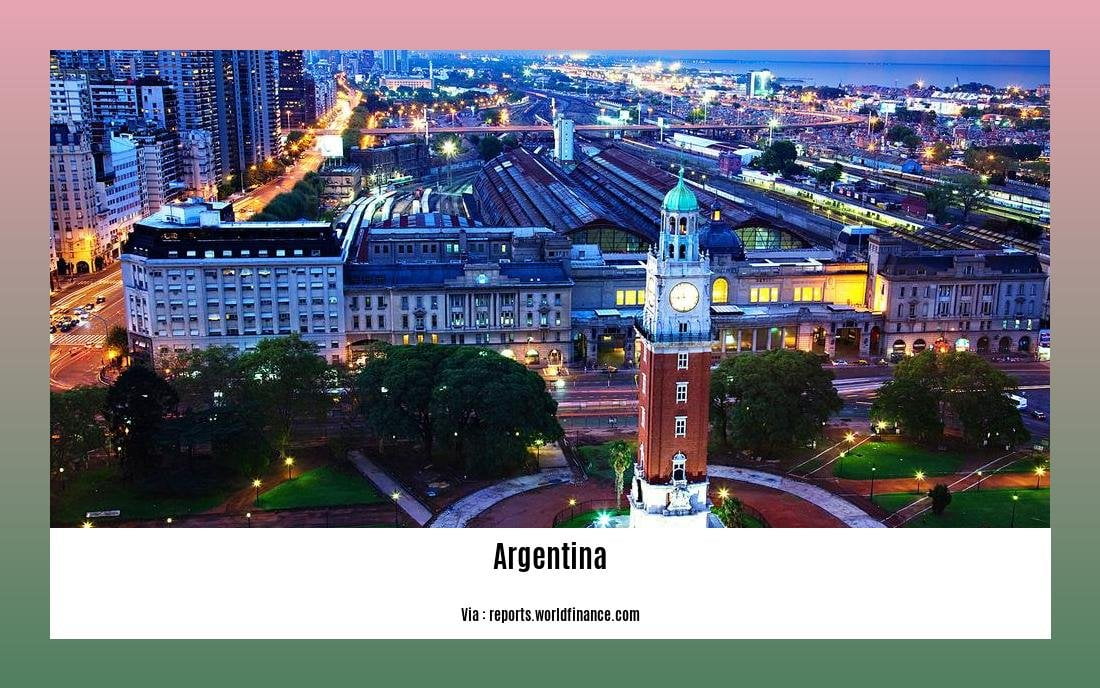Get ready to be amazed as we uncover the marvels of Argentina with these 10 fun facts. From a football legend inspiring a religion to being home to the world’s largest population of Magellanic penguins, Argentina is a country full of surprises. Did you know that the world’s first animated feature film was made right here in Argentina? And if you’ve ever wondered why cowboys are called Gauchos in South America, we’ve got the answer for you. Prepare to be captivated by the fascinating wonders of Argentina!
Key Takeaways:
- Argentina is the eighth-largest country in the world, covering over 1 million square miles.
- With a population of over 46 million, Argentina is the second-largest nation in South America.
- The official language of Argentina is Spanish.
- Mount Aconcagua, located in the Andes, is both the highest point in Argentina and the Western Hemisphere.
- Buenos Aires is home to the largest mosque in Latin America, the King Fahd Islamic Cultural Centre.
- Football is the most popular sport in Argentina and holds significant cultural importance.
- El Pato, a unique mix of polo and basketball, is Argentina’s official national sports.
- Tango, a passionate dance, originated in the working-class neighborhoods of Buenos Aires.
- Argentina is renowned for its beef production and is a leading exporter.
- Wine production is also prominent in Argentina, particularly in regions like Mendoza and Salta.
- Iguazu Falls, located on the Argentina-Brazil border, is a spectacular natural wonder.
- Siesta, a short nap in the afternoon, is widely practiced in Argentina, leading to businesses and shops closing during those hours.
- Argentina has a strong literary tradition, producing renowned writers such as Jorge Luis Borges and Julio Cortazar.
- Argentina has won the FIFA World Cup twice, in 1978 and 1986, emphasizing its rich soccer history.
- Mate, a traditional drink made from yerba mate leaves, is beloved by Argentineans.
- Tango encompasses both a dance and a musical genre, originating in Argentina.
- Ushuaia, located in Tierra del Fuego, is the world’s southernmost city.
- Argentina’s “asados” are famous barbecues featuring various meats cooked over an open fire.
- Evita Peron, the second wife of Argentine President Juan Peron, holds a significant role in Argentine politics and social welfare.
- Diego Maradona, a famous Argentine soccer player, is considered one of the greatest players in history.
- Argentina has a strong passion for polo and hosts major tournaments attracting players worldwide.
- The Argentine peso is the country’s currency.
- Argentina’s landscapes range from the glaciers of Patagonia to the colorful rock formations of the Quebrada de Humahuaca.
Argentina Fun Facts


Argentina is a captivating country that offers a wealth of amazing surprises and fascinating tidbits. From its vast landscapes to its vibrant culture, there is no shortage of incredible fun facts to uncover. Here are some mind-blowing Argentina fun facts that will leave you amazed:
1. A Land of Massive Proportions
Argentina is a colossal country, covering over 1,068,296 square miles. That makes it the eighth-largest country in the world! With such immense territory, it’s no wonder Argentina boasts an array of breathtaking landscapes, from the Andes mountains to the stunning glaciers of Patagonia.
2. Spanish is the Language of Argentina
The majority of Argentines speak Spanish, the country’s official language. So if you’re planning a trip, brushing up on some basic Spanish phrases will certainly come in handy when exploring this beautiful nation.
3. Mount Aconcagua: A Record-Breaking Summit
Did you know that Mount Aconcagua, located in Argentina’s Andes mountain range, is not only the highest point in the country but also the highest mountain peak in the entire Western Hemisphere? Standing tall at an impressive 22,837 feet, this majestic summit is a sight to behold for any adventure enthusiast.
4. A Hub of Culture and Diversity
Buenos Aires, Argentina’s capital city, is renowned for its cultural richness. Here you’ll find the largest mosque in Latin America, the King Fahd Islamic Cultural Centre. With its stunning architecture and vibrant atmosphere, it’s a testament to the diverse blend of cultures that exist within Argentina.
5. Football: A National Passion
Although it may not be the official national sport, football, or soccer, holds a special place in the hearts of Argentines. This thrilling sport is deeply ingrained in the country’s culture and is regarded as a symbol of national pride. Argentina has produced some of the world’s greatest football players, such as Diego Maradona and Lionel Messi.
6. Discover El Pato: Argentina’s Unique National Sport
While most countries have traditional sports like rugby or cricket, Argentina’s national sport is a lesser-known game called El Pato. This fascinating sport combines elements of polo and basketball, creating an exciting and unique experience for both players and spectators alike.
7. Tango: The Dance of Passion
No discussion of Argentina would be complete without mentioning the passionate and seductive Tango. Originating in the working-class neighborhoods of Buenos Aires, this iconic dance form has captivated audiences worldwide with its intensity and emotional expression.
8. Argentina: A Meat Lover’s Paradise
If you’re a fan of delicious meat, Argentina is the place to be. The country is famous for its beef and is one of the largest beef-producing and exporting nations globally. Argentineans have perfected the art of grilling, and their traditional barbecues, known as “asados,” are a mouthwatering delight for any food lover.
9. Wine Country: Argentina’s Liquid Treasure
Argentina is not just about meat; it’s also renowned for its world-class wines. Regions such as Mendoza and Salta produce exceptional wines that are enjoyed around the globe. So be sure to raise a glass and savor the rich flavors of Argentina’s vineyards during your visit.
10. Nature’s Masterpiece: The Iguazu Falls
Prepare to be amazed by the breathtaking Iguazu Falls, situated on the border of Argentina and Brazil. These mesmerizing waterfalls are one of the most awe-inspiring natural wonders in the world. With their thundering cascades and verdant surroundings, the Iguazu Falls are a sight that will leave you in awe.
Argentina is a land of wonders, from its expansive landscapes to its rich cultural heritage. Whether you’re exploring the bustling streets of Buenos Aires, marveling at the natural beauty of Patagonia, or indulging in mouthwatering Argentine cuisine, this vibrant country offers an unforgettable experience. So pack your bags and get ready to uncover the marvels of Argentina, where every corner reveals a new and fascinating fun fact.
Check out these fascinating Argentina fun facts about its culture: argentina fun facts culture. From tango to mate, Argentina has a vibrant cultural scene that will amaze you!
Immerse yourself in the intriguing world of Argentina with these fun facts in Spanish: argentina fun facts in spanish. Descubre datos curiosos de Argentina y su rica cultura en español.
Explore the wonders of the Arizona desert with these interesting facts: arizona desert facts. From magnificent cacti to breathtaking landscapes, the desert will leave you in awe.
Want to know more about the specific regions in the Arizona desert? Discover fascinating facts about the desert region in Arizona: arizona desert region facts. Explore the unique characteristics of each region and unleash your adventurous spirit.
12. The World’s First Animated Feature Film Was Made in Argentina
Did you know that Argentina holds the title for producing the world’s first animated feature film? Yes, it’s true! In 1917, Quirino Cristiani and Federico Valle created a groundbreaking film called “El Apóstol,” which became the very first full-length animated feature film in history.
1. An Animated Satire:
“El Apóstol” was not just an animated film; it was a satirical commentary on political corruption within Buenos Aires. This film marked a significant milestone in the history of animation, combining entertainment with a powerful message.
2. Pioneering Animation Techniques:
Produced using cutout animation, “El Apóstol” consisted of a staggering 58,000 drawings. This feat was made possible by the dedication and ingenuity of Quirino Cristiani and Federico Valle, who directed and produced the film.
3. The Root of Argentina’s Animated Film Industry:
The success of “El Apóstol” marked the beginning of a vibrant animated film industry in Argentina. The country’s passion for animation continued to grow, with other notable films like “Sin Dejar Rastros” in 1918, further solidifying Argentina’s presence in the world of animation.
4. Recognition and Legacy:
While the achievements of Walt Disney in the field of animation are widely celebrated, it is essential to recognize the pioneering work of Quirino Cristiani. He was an Italian immigrant who played a crucial role in shaping the Argentine animated film industry and paved the way for future filmmakers.
5. Tragic Loss and Resilience:
Tragedy struck Quirino Cristiani a year after the release of “El Apóstol” when he premiered his film “Sin Dejar Rastros.” Unfortunately, this film was destroyed in a fire, resulting in the loss of an incredible piece of animation history. However, Cristiani’s passion and resilience were not dampened, and he went on to create the first animated feature film with sound.
6. Argentina’s Continued Contribution:
Argentina’s animation industry continues to thrive and make significant contributions to the global film scene. Recent releases like “Metegol” in 2013 have garnered attention and recognition both within Argentina and beyond. In fact, “Metegol” had the esteemed Weinstein Company involved in its distribution in the United States.
Argentina’s animation industry is an essential part of its cultural heritage, and the achievements of pioneers like Quirino Cristiani deserve recognition alongside the more well-known figures in animation history. So, remember, the next time you watch an animated feature film, take a moment to appreciate Argentina’s role in shaping this captivating art form.
Key Takeaways:
– Argentina is the birthplace of the world’s first animated feature film, “El Apóstol.”
– “El Apóstol,” released in 1917, was a satirical commentary on political corruption.
– The film was made using cutout animation and consisted of 58,000 drawings.
– Quirino Cristiani and Federico Valle directed and produced “El Apóstol,” solidifying Argentina’s position in the animated film industry.
– Quirino Cristiani’s work laid the foundation for the development of the Argentine animated film industry.
– Despite facing setbacks, Argentina continues to make significant contributions to the animation world with recent releases like “Metegol.”
Sources:
– IdeaRocket – “Animation Thrives In Argentina: A Brief History”
– Wikipedia – “El Apóstol”
14. Cowboys are Called Gauchos in South America
Key Takeaways:
– Gauchos are nomadic cowhands and horsemen who were an integral part of Argentina and Uruguay’s history.
– They were known for their expertise in horse riding, outdoor skills, and hunting.
– Gauchos were often seen as generous yet unruly figures in the country’s past.
– They played a significant role in shaping Argentina’s culture and traditions.
Argentina, a land of mesmerizing landscapes and vibrant culture, holds many intriguing secrets. One fascinating fact about this South American country is that cowboys are called gauchos. These nomadic and colorful figures were the cowhands and horsemen of the Argentine and Uruguayan Pampas, vast grasslands that stretch across the region.
The term “gaucho” has become synonymous with Argentina’s rich history and cultural heritage. These skilled horse riders were known for their daring escapades and unruly behavior, often romanticized in folklore and literature. The gauchos played an essential role in the cattle industry, herding and tending to the vast herds that roamed the expansive grasslands.
Gauchos possessed exceptional outdoor skills, honed through years of life on the Pampas. From their mastery of horse riding to their expertise in hunting, they were a symbol of Argentina’s frontier spirit and independence. Their distinctive attire, comprising wide-brimmed hats, loose-fitting trousers called bombachas, and intricately woven ponchos, further added to their enchanting allure.
While gauchos were renowned for their independence, they were also known for their generosity. They would often offer assistance to those in need, sharing their food, shelter, and expertise with fellow travelers. However, their wild and untamed nature meant they were sometimes viewed as outlaws, challenging authority and embracing a free-spirited lifestyle.
Today, Argentina celebrates the gaucho legacy through various cultural events and festivals. These festivities showcase their horsemanship skills, traditional music, and vibrant folk dances like the malambo, which originated from gaucho gatherings. Visitors to Argentina have the opportunity to witness firsthand the spirit of the gauchos by attending rodeos known as “domas” or visiting working estancias (ranches).
Argentina’s gauchos are an essential part of the country’s identity, representing its rich history and traditions. They were not just cowboys but vibrant characters who embodied the spirit of the Pampas. So, as you venture into the heartland of Argentina, take a moment to appreciate the storied legacy of the gauchos and their captivating presence in the country’s heritage.
Sources:
– Britannica – Gaucho | Meaning, History, Pants, & Facts
– Culture Trip – A Brief History of the Gaucho: the Cowboys of Argentina
FAQ
Q1: What is the significance of football in Argentina?
A1: Football holds great cultural significance in Argentina and is the most popular sport in the country. It is seen as an icon and a source of national pride.
Q2: How did Maradona inspire a religion?
A2: Maradona’s immense talent and success in football led to his worshipped status, particularly in Argentina. Some fans have formed a religious following centered around him, viewing him as a divine figure.
Q3: Why is Argentina home to the world’s largest population of Magellanic penguins?
A3: Argentina’s coastline and proximity to the Southern Ocean provide an ideal habitat for Magellanic penguins. The country’s protected areas and environmental conservation efforts have helped sustain their population.
Q4: What was the world’s first animated feature film made in Argentina?
A4: The world’s first animated feature film, “El Apóstol,” was made in Argentina. It was a satire commenting on political corruption within Buenos Aires and utilized cutout animation techniques.
Q5: What are gauchos and why are they significant in South America?
A5: Gauchos are the colorful cowhands and horsemen of the Argentine and Uruguayan Pampas. They played a significant role in the history and culture of Argentina and are known for their expertise in horse riding, outdoor skills, and hunting.
- China II Review: Delicious Food & Speedy Service - April 17, 2025
- Understand Virginia’s Flag: History & Debate - April 17, 2025
- Explore Long Island’s Map: Unique Regions & Insights - April 17, 2025
















